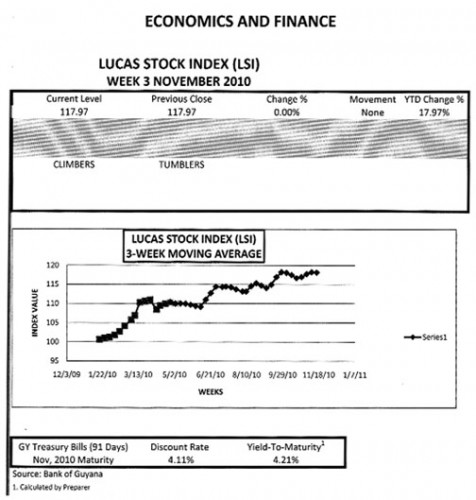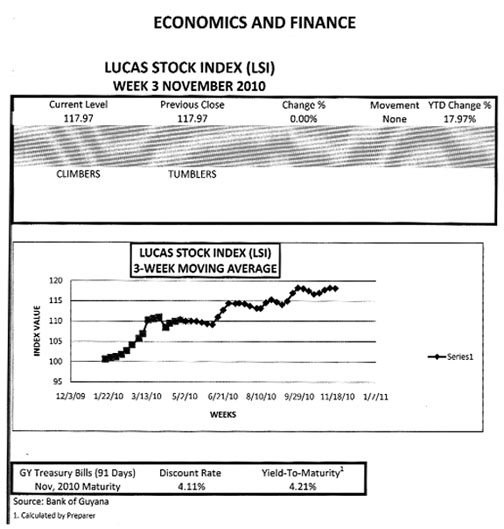Official Trade
Gold prices have been setting nominal records in 2010 as prices moved from US$1,148 in April to over US$1,400 in November. Even though prices have dropped under US$1,400, they remain attractively high. For Guyana, this means higher export revenues since gold exports are on track to exceed the 312,000 ounces that left the country through official trade in 2009. This outcome is good for an industry which has come under increasing pressure from the administration to change its production practices in order to comply with the low carbon development strategy. While gold prices might be the main attraction, rice production has been on the rise also and could add to the favourable outlook. Export revenues as a whole could increase between 12 to 16 percent based on the higher level of the export revenue index that involves Guy-ana’s main export items. A major consideration to the projected higher levels of the index is whether Guyana could sustain production levels that enable it to take advantage of the favourable market prices.
Lingering Discord
The expected growth is rather fortuitous rather than the result of strategic action by the administration. The driver of the favourable mar-ket prices is the unsteady and uneasy conditions of the global economy. Thanks to an uneven recovery among the world’s largest econo-mies and lingering discord among them of how to right their listing economic ships, Guyana is set to obtain some benefits from its major exports. It is rare for export-ers of primary commodities to see favourable export revenues while the global economy is going through the type of severe economic trauma that it is experiencing. As an acknowledgement of this phenomenon, the administration noted in its 2010 budget presentation that “… if a global recovery is actually underway it is still in its earliest days and is still subject to significant risks, and small economies like ours remain extremely exposed to the pace and depth of this recovery …”. With most of their exports dependent on trading partners who must be healthy to keep demand for these commodities high, developing countries like Guyana rarely get to enjoy good revenues during hard economic times.
 Silver Lining
Silver Lining
Yet, there is a silver lining for exporters of primary commodities like Guyana behind the dark economic clouds hovering over the global economy. The bright prospects for good economic times are coming from the dysfunction of the global economy. A confluence of events that reflect the changing dynamics of global economic power and the uncertainty of how to respond to this change is helping to create favourable conditions for Guyana. The conflict between the Chinese yuan and the US dollar is an example of this unresolved economic power shift that is helping to improve the export revenue of Guyana. Without action by China to push the value of the yuan up vis-à-vis the dollar, it is reasonable to expect that the US will seek ways to improve its own position in this competitive relationship, especially since the US sees export-led growth as one way of resolving its economic crisis.
Reaction
Quite recently, the US Federal Reserve decided to pump lots of money into the US economy, a course of action described as quantitative easing. That action is seen as potentially inflationary with the likely result that the US dollar will lose value and make its exports competitive. The lower dollar will help to revive growth prospects for the economy. This action is helping to push commodity prices higher since commodities are priced in dollars. Sugar, rice and gold among other commodities have seen an increase in prices. The price of rice is still below the record levels it reached in 2008 and even 2009 prices, but it has been rising since June 2010 and could only help to expand the export revenue base.
Little Comfort
Where Guyana is concerned, gold has been returning the highest export revenues for a long time. The abnormally high prices and higher production levels would give gold even more weight in the Guyana economy. In addition to unease among the major economic players, the price of gold has been helped by higher oil prices. Even though oil prices are a little lower today than they were a week ago, its steady rise in value began to create fears of inflation and a search by investors for a refuge for their money. The unresolved real estate crisis in the US domestic market offers investors little comfort and is causing them to look for alternatives. Not too many attractive choices are being found in the stock market as many companies profit levels remain low. This is where gold often stands tall. It has always been the refuge of choice when investors have no alternative assets or investment options to rely on. Unless the global economy settles down, the price of gold is likely to remain attractively high and help to improve the growth prospects of the Guyana economy. This is especially true when a country exports a commodity that people want.

